 Red
Red: indicates areas where this non-native
species has been found and could be established.
This anole appears to be expanding its range in California
and is very likely to be found in other areas not shown here.
Click on the map for a topographical view
Map with California County Names
|
This species has been introduced into California. It is not a native species.
|
 |
| Adult male displaying his orange dewlap, Florida |
 |
 |
 |
 |
Adult male displaying dewlap, Vista,
San Diego County © Len Geiger |
Adult male displaying dewlap, Irvine,
Orange County © L. Thomas |
Adult, Vista, San Diego County
© Len Geiger |
Adult, Vista, San Diego County
© Len Geiger |
 |
 |
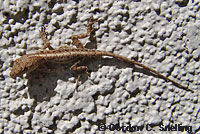 |
 |
Adult, Vista, San Diego County
© Len Geiger |
Adult male displaying dewlap, Vista,
San Diego County © Len Geiger |
Adult, Huntington Beach, Orange County © Gordon Snelling |
Adult, Palm Springs, Riverside County
© Jeremiah Easter
|
 |
 |
 |
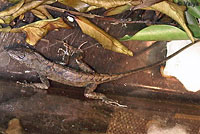 |
| Adult male, Palm Desert, Riverside County © Charlie Wheeler |
Adult male, Rancho Mirage, Riverside County © Valya |
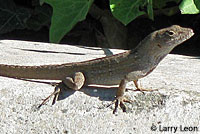 |
 |
 |
 |
| Adults, Santa Ana, Orange County © Larry Leon |
Adult, Santa Ana, Orange County
© Mark Garcia |
Adult, Santa Ana, Orange County
© Mark Garcia |
| |
|
|
|
| Juveniles |
 |
 |
|
|
Hatchling, Orange County
© James Chiate |
Adult and Juvenile, Huntington Beach, Orange County © Gordon Snelling |
|
|
| |
|
|
|
| Brown Anoles from Outside California |
 |
 |
 |
 |
| Adult male, Miami-Dade County, Florida, displaying distended orange dewlap with yellow border. |
Adult male displaying dewlap, Monroe County, Florida |
Adult male, Monroe County, Florida |
 |
 |
 |
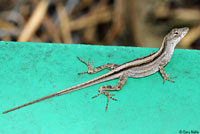 |
| Adult female, Monroe County, Florida |
Adult male, Monroe County, Florida |
Adult female, Miami-Dade County, Florida |
Adult female, Miami-Dade County, Florida |
 |
 |
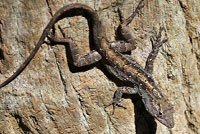 |
 |
| Adult male, Miami-Dade County, Florida |
Adult female, Sarasota County, Florida |
Adult female, Miami-Dade County, Florida |
 |
 |
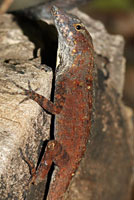 |
|
| Adult female, Sarasota County, Florida |
Adult female, Monroe County, Florida |
Adult male, Monroe County, Florida |
|
| |
|
|
|
| Habitat |
 |
 |
 |
|
Some of the lush imported ornamental vegetation in developed desert areas of the
Coachella Valley in Riverside County, where brown anoles have been seen. |
| |
| Short Videos |
 |
 |
 |
|
A male brown anole in Florida
displays his orange dewlap. |
A male brown anole in Florida
displays his orange dewlap. |
A male brown anole extends and retracts his orange dewlap several times to advertise his presence.
San Diego County © Joe Culligan |
|
| |
|
|
|
| Description |
| |
| Size |
Adult males grow up to 2.5 inches in length (6.5 cm) from snout to vent.
They can grow as long as about 8 inches (20.3 cm) including a full tail.
Females are smaller, up to about 1.9 inches in length (4.8 cm) from snout to vent. (Meshaka Jr. et al 2004)
|
| Appearance |
| A small thin lizard with a long head and snout and a long thin tail. |
| Male Color and Pattern |
Males are brown or gray with a white streak down the center of the throat (which is the light bottom border of the dewlap.) This streak is not always very prominent.
The color of a lizard can change from light gray to dark brown.
The male dewlap is typically bright orange-red with a cream to yellow border, but sometimes varies to a pale yellow (due to extensive intergradation of two subspecies. (Bartlett, 1999)
Sometimes 6 or more vertical rows of spots are visible.
Some males have a pronounced crest on the top of the neck and back, and sometimes the tail. |
| Female Color and Pattern |
Females are gray to brown with a narrow pale stripe on the center of the back with dark brown half circles on each side, creating the appearance of a scalloped pattern on the back.
The color of a lizard can change from light gray to dark brown. |
| Comparisons With Green Anole |
Brown Anoles are less arboreal than Green Anoles, tending to stay closer to the ground.
Green Anoles tend to go higher up into trees, although they can also be found lower down.
Brown Anoles are always gray, light brown, or dark brown, never green.
Green Anoles can turn from dark brown to bright green.
Male Brown Anoles have a bright orange-red dewlap with a cream to yellow border.
Male Green Anoles have a pink dewlap.
(Be aware that dewlaps appear different colors when seen in different lights.)
Brown and Green Anoles are about the same size, but Green Anoles have a larger and longer head.
|
| Life History and Behavior |
Activity |
Often seen basking in the sun on rocks, bushes, fences, walls, and tree tree trunks.
Males bask on higher sites than females and juveniles.
Adapt well to habitats modified by humans.
Sometimes seen foraging at night under lights.
(Meshaka Jr. et al 2004)
|
| Predators |
| In Florida, predators include several other species of alien lizards, Cuban treefrog, American crow, corn snake, ring-necked snake, broad-winged hawk, and cattle egret. (Meshaka Jr. et al 2004) |
| Diet and Feeding |
| Eats mostly insects and other small invertebrates. Hatchling Green Anoles are also consumed and most likely other hatchling lizard species, including Brown Anoles. |
| Reproduction |
A study in Miami (Lee et al., 1989) found reproduction to be seasonal, peaking from April through June, with the fewest reproductively active lizards found from November through January for males and November through February for females. (Meshaka Jr. et al 2004)
Females lay several eggs each summer roughly each 14 days, one egg at a time. Eggs hatch in about a month. (Bartlett, 1999)
|
| Habitat |
Habitat in California is suburban ornamental landscaping.
|
| Geographical Range |
Anolis sagrei is native to Cuba, the Bahamas, and surrounding islands, and has been widely introduced to other areas, including other Caribbean islands, most of Florida, southern Georgia, Texas, Arizona, Jamaica, Mexico, Central America, South America, including Ecuador, Oahu Hawaii, Singapore, and Taiwan.
Introduced into Florida in the mid 20th century. Earliest records are from 1950 and early colonies were associated with sea ports. Has spread to most of peninsular Florida, most likely dispersed by human agency - as abandoned or escaped pets or feeder animals and as stowaways in landscaping plants and in other cargo on boats and other vehicles. (from: Meshaka Jr. et al, 2004)
____________________________________________________________________________________________________________________________________
This species was first documented in California on this web site in 2009 at a location in the Coachella Valley, but most likely it has been present in the state for longer.
The first published documentation was in Herpetological Review 45(4), 2014, an edited version of which you can read below:
ANOLIS SAGREI (Cuban Brown Anole). USA: CALIFORNIA: San Diego Co.: Vista, elev. 158 m) 19 July 2014.
C. Mahrdt, E. Ervin, and L. Geiger. Verified by Bradford D. Hollingsworth. San Diego Natural History Museum (SDSNH 76128–76133).
New county and state record (Granatosky and Krysko 2013. IRCF Rept. Amphib. 20[4]:190–191)
Four adult males and two hatchling specimens were collected on a one-acre parcel landscaped with palms, cycads, and several species of tropical plants and ground cover. Several boulders scattered throughout the parcel were used as perch sites for male lizards. An additional 16 adults and six hatchlings were observed in the two-hour site visit (1030–1230 h). Adults were also observed beyond the property indicating that this population is established and likely expanding through the contiguous tropical landscaping of neighboring properties. According to the property owner, he first observed the species in August 2012 shortly after receiving shipments of palm trees in May–August originating from suppliers located in the Hawaiian Islands.
____________________________________________________________________________________________________________________________________
INaturalist includes a large list of observations of this species around the world with a map that will let you zoom in to see locations in California.
____________________________________________________________________________________________________________________________________
Some Locations Where Wild Brown Anoles Have Been Seen in California
Brown Anoles
may not be established in all of these areas. Some of thse sightings might be lizards that stowed away in shipments from areas where the species has become established, such as Florida. These are only areas I have heard about so far from museum records, email, or iNaturalist records. I can't know about every sighting, so they are very likely to be found and are likely to be established in other areas not included on this list. Eventually the Brown Anole will probably be found throughout much of coastal Southern California along with the Green Anole. I will continue to add locations here and on the map as I learn of them. If you see any wild Brown Anoles in California or know about any locations that are not on this list, please email me.
Butte County
Paradise
Kern County
Near Arvin
Los Angeles County
Arcadia
Culver City
Long Beach
Rosemead
Whittier
Orange County
Costa Mesa
Fullerton
Huntington Beach
Irvine
La Habra
Mission Viejo
Placentia
Santa Ana
Yorba Linda
Riverside County
Palm Desert
Palm Springs
Rancho Mirage
Riverside
Sacramento County
Near Rancho Cordova
San Diego County
Bay Park
Cardiff
Chula Vista
El Cajon
Encinitas
Ocean Beach
San Diego
-College Area
-Del Mar
San Marcos
Vista
Ventura County
Ventura
|

Approximate native range and range of introductions anywhere within the red areas.
(Also
reported at scattered locations throughout the eastern U.S.A.)
|
| Notes on Taxonomy |
"According to Conant and Collins (1991, Reptiles and Amphibians of Eastern and Central North America, Houghton Mifflin Co.), two subspecies, A. s. sagrei and A. s. ordinatus were introduced to southern Florida, but they can no longer be distinguished from one another and differ from both original races. Lee (1992, Copeia 1992: 942-954) presented evidence that the Florida populations bear a much stronger phenotypic resemblance to populations from Cuba (A. s. sagrei) than to those from the Bahamas (A. s. ordinatus). Kolbe et al. (2004, Nature 431:177-181) present evidence for multiple introductions of this species from Cuba to Florida, which suggests that A. s. greyi may also have been involved."
(SSAR Herpetological Circular No. 39, 2012)
(The subspecies Anolis sagrei greyi Barbour, 1914 is from Cuba. Also (Anolis greyi - Grzimek et al. 2003 & Norops sagrei greyi - Nicholson et al. 2012)
|
| Conservation Issues (Conservation Status) |
This anole is thought to have contributed to the decline of native Green Anoles in Florida. (Meshaka Jr. et al 2004)
The impact of this invasive species on native California lizards and other wildlife is not well known, however native lizards observed living in proximity with this species most likely suffer from the extra competition.
"Repeated surveys at other Southern California localities where nonnative Anolis carolinensis, Anolis sagrei, and Podarcis siculus occur have shown displacement of S. occidentalis as nonnative populations expand (Pauly, unpubl. data)."
(Gregory B. Pauly and Patrick D. Gavid. Geographical Distribution Note for Trachylepis quinquetaeniata in Los Angeles County. Herpetological Review 50(1), 2019.) |
|
|
Taxonomy |
| Family |
Dactyloidae |
Anoles |
Fitzinger, 1843 |
| Genus |
Anolis (Norops) |
Anoles |
Daudin, 1802 |
Species
|
sagrei |
Brown Anole |
Dumeril and Bibron, 1837 |
|
Original Description |
Dumeril and Bibron, 1837
|
|
Meaning of the Scientific Name
|
Anolis - West Indian anoli lizard — Native Antillean name
from Scientific and Common Names of the Reptiles and Amphibians of North America - Explained © Ellin Beltz
sagrei - in honor of Spanish botanist Ramón de la Sagra.
|
|
Alternate Names
|
None
|
|
Related or Similar California Herps
|
Green Anole - Anolis carolinensis (Alien Species)
|
|
More Information and References
|
Robert Powell, Roger Conant, and Joseph T. Collins. Peterson Field Guide to Reptiles and Amphibians of Eastern and Central North America. Fourth Edition. Houghton Mifflin Harcourt, 2016.
Conant, Roger, and Joseph T. Collins. A Field Guide to Reptiles and Amphibians Eastern and Central North America.
Third Edition, Houghton Mifflin Company, 1998.
R. D. Bartlett, Patricia P. Bartlett. A Field Guide to Florida Reptiles and Amphibians. Gulf Publishing Company. 1999.
Walter E. Meshaka, Jr., Brian P. Butterfield, and J. Brian Hauge. The Exotic Amphibians and Reptiles of Florida. Krieger Publishing Copany 2004.
SSAR Herpetological Circular No. 39, 2012.
SCIENTIFIC AND STANDARD ENGLISH NAMES OF AMPHIBIANS AND REPTILES OF NORTH AMERICA NORTH OF MEXICO, WITH COMMENTS REGARDING CONFIDENCE IN OUR UNDERSTANDING. SEVENTH EDITION
COMMITTEE ON STANDARD ENGLISH AND SCIENTIFIC NAMES BRIAN I. CROTHER (Committee Chair)
Romero, V., Maxi, E., Cando, K., Vega, M., Sozoranga, J., & Saa, L. R. (2025). Borderless Lizards: Unveiling Overlooked Records and the Expanding Invasion of Anolis sagrei in Ecuador. Diversity, 17(5), 339. https://doi.org/10.3390/d17050339
|
|
|
The following conservation status listings for this animal are taken from the July 2025 State of California Special Animals List and the July 2025 Federally Listed Endangered and Threatened Animals of California list (unless indicated otherwise below.) Both lists are produced by multiple agencies every year, and sometimes more than once per year, so the conservation status listing information found below might not be from the most recent lists, but they don't change a great deal from year to year.. To make sure you are seeing the most recent listings, go to this California Department of Fish and Wildlife web page where you can search for and download both lists:
https://www.wildlife.ca.gov/Data/CNDDB/Plants-and-Animals.
A detailed explanation of the meaning of the status listing symbols can be found at the beginning of the two lists. For quick reference, I have included them on my Special Status Information page.
If no status is listed here, the animal is not included on either list. This most likely indicates that there are no serious conservation concerns for the animal. To find out more about an animal's status you can also go to the NatureServe and IUCN websites to check their rankings.
Check the current California Department of Fish and Wildlife sport fishing regulations to find out if this animal can be legally pursued and handled or collected with possession of a current fishing license. You can also look at the summary of the sport fishing regulations as they apply only to reptiles and amphibians that has been made for this website.
This species is not yet listed as a California alien by the California Dept. of Fish and Wildlife
|
| Organization |
Status Listing |
Notes |
| NatureServe Global Ranking |
|
|
| NatureServe State Ranking |
|
|
| U.S. Endangered Species Act (ESA) |
None |
|
| California Endangered Species Act (CESA) |
None |
|
| California Department of Fish and Wildlife |
None |
|
| Bureau of Land Management |
None |
|
| USDA Forest Service |
None |
|
| IUCN |
|
|
|
|











































